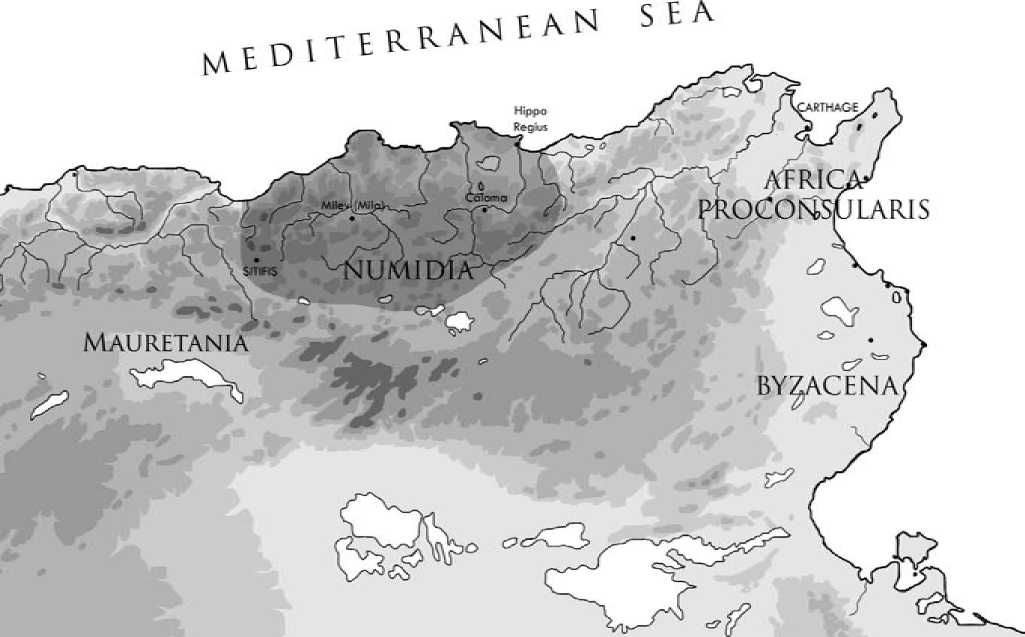The Vandal kingdom took time to develop into its final form. Growth and change continued throughout the century in which the group ruled Carthage, but the main features of the new state emerged during the first decade and a half in North Africa. Within this period, Geiseric was presented with a number of challenges: to consolidate the position of his followers within the rich lands of the region; to secure the state against external enemies; and to confirm his own position (and that of his family) at the heart of the newly created Vandal state. The solutions which he adopted established the foundations of his kingdom, but also had a profound effect upon the lives of his subjects. Identities solidified, social structures were clarified, and Geiseric was able to create a new Vandal monarchy, suited to the rich lands in which his people had found themselves. As a starting point for a new kingdom, the grand experiment of the period from 435-445 was a resounding success.
The first formal treaty between the Vandals and the western empire was signed on 11 February 435 and bought a temporary peace to the region.10 Augustine’s former diocese at Hippo Regius became Geiseric’s first capital, and the lands ceded for the settlement of the Vandals were probably restricted to northern Numidia and perhaps parts of Africa Proconsularis or Mauretania Sitifiensis. Treaties of this kind were common in the western empire, and indeed had long formed part of the imperial strategy for accommodating groups of federate barbarians. The Vandals themselves had requested a similar treaty following their occupation of Spain in the 410s, and may conceivably have been bribed by a foedus of some description during the negotiations with Boniface in the late 420s. Typically, treaties like these offered land, subsidies and some practical autonomy to the barbarian group in question, but placed them in a subordinate position to the western empire, and demanded military service
Geiseric rapidly outgrew his status as a junior federate. Shortly after settling in Hippo, the king expelled three prominent bishops from their sees - Possidius of Calama, Novatus of Sitifis, and Severianus, probably the bishop of Mila.12 At around the same time, the king instituted a purge of his court and removed four prominent Hispano-Roman courtiers as well as some minor functionaries from his entourage, ostensibly for their refusal to convert to Arianism.13 While these actions - particularly those against the church - probably overstepped the terms of his treaty, Geiseric’s apparent indifference to the military responsibilities that came with federate status had far more serious implications. As early as 437, pirates became increasingly active within the Mediterranean, and these may well have been Vandals, operating with the king’s tacit
The most serious blow came two years later: on 19 October 439, with Aetius otherwise engaged in Gaul, and the imperial garrison in Carthage apparently unaware of the impending danger, Geiseric occupied the city.15 The psychological impact of the fall of Carthage was considerable. As contemporary sources attest, the arrival of the Vandals was met with widespread panic and flight among the local population.16 Christian sermons of the period and Victor’s Historia all suggest that the occupation was a violent one, but this does not seem to have been the case. Portable goods, both secular and ecclesiastical, were certainly plundered, and some Catholic churches were handed over to the Arians or closed within a few months of the occupation, but as yet there is little archaeological evidence for extensive structural damage at the moment of the immediate aftermath of the occupation.17
The treaty of 442 and the subsequent divisions of the African spoils were the point at which the Vandal regnum truly came into being.18 Stunned

Figure 3.2 The Vandal kingdom after the treaty of ad 435
By the loss of Carthage, and chilled by the recent Vandal attacks on Sicily and Southern Italy, the emperor Valentinian in Italy was forced to compromise with Geiseric for a second time. In his Chronicle, Prosper states explicitly that ‘peace was confirmed with Geiseric and the emperor Valentinian and Africa was divided between the two into distinct terri-tories’.19 This form of agreement was new. Whereas previous treaties, including that of 435, had granted land to barbarian groups for settlement, but had retained nominal sovereignty in the name of the empire, Prosper’s forceful language suggests that there was a genuine division of land in 442. No longer simply federates of the empire, it seems that the Vandals were being given lands of their own. Other aspects of the treaty confirm this impression. According to Procopius, Geiseric’s eldest son Huneric was sent as a hostage to the imperial court - indeed a number of poems composed in Ravenna at that time seem to refer to the young prince.20 It was probably in this period, or shortly afterwards, that Huneric was betrothed to the imperial princess Eudocia, a dynastic union that was to play a central role in Geiseric’s foreign policy over the decades that followed. No less important was the annual tribute (das-mos) to be paid from Carthage to the western emperor, which Procopius states was an important part of the agreement.21 Crucially, payment flowed from the barbarians to the empire, and not the other way around, as was the case in all previous settlement treaties. The Vandals, in other words, were no longer paid employees of the Roman state.
The new Vandal kingdom was substantial. Victor of Vita’s account of the treaty gives some impression of the division between the ‘two distinct territories’ of Roman and Vandal jurisdiction:
[Geiseric] also made an arrangement concerning the individual provinces: Byzacena, Abaritana and Gaetulia, and part of Numidia he kept for himself. Zeugitana and the Proconsular province he divided up as ‘heritable lots’ for his army; and he allowed Valentinian, who was still emperor, to take for himself the remaining, and now devastated provinces.22
On the face of it, the division seems clear enough: the Vandals took for their own the rich grain-producing lands of Zeugitana (Africa Proconsularis) and eastern Numidia;23 in addition, the treaty granted Geiseric jurisdiction over the Roman province of Byzacena (or Byzacium), incorporating the rich cereal lands in the hinterland of Hadrumetum and the eastern coastal plain, as far as the mountains and pre-desert of what is now western Tunisia and the Algerian border. Abaritana and Gaetulia are more difficult to identify, and may well have been new administrative divisions, introduced by the Vandal government

Figure 3.3 The Vandal kingdom after the treaty of ad 442
Around the time of the treaty.24 While their identification is not certain, Abaritana has been plausibly associated with the Aures massif, in the south-east of Numidia, and Gaetulia with the plains immediately to the north.25 Although Victor does not mention it, the Vandals also probably took control of the coastal strip of western Tripolitana.26 For his part, Valentinian evidently retained control over the three Mauretanian provinces (Tingitania, Caesariensis and Sitifiensis), as well as the easternmost part of Numidia.
This territorial division was observed down to Valentinian’s death in 455. From the imperial perspective, the great virtue of the treaty was that it ended the Vandal attacks, and firmly asserted Valentinian’s control over the Mauretanias and western Numidia. A spate of imperial legislation from the 440s and early 450s demonstrates that the government in Ravenna took their responsibilities over these regions seriously. Within these proclamations (novellae), Valentinian remitted taxes for those landholders who had suffered in the recent wars, supervised the imperial estates and occasionally granted portions of them to those who had seen their own lands confiscated by the Vandals, and he did his best to manage the chaotic military situation at the Numidian frontiers.27 These laws read as sensible, pragmatic responses to a dramatically changed situation in North Africa, and as a realistic attempt at damage limitation.
Having said that, Valentinian clearly had not given up hope of reclaiming the provinces lost to the Vandals. The legislation which he passed relating to African refugees within Italy, and to those individuals who had lost lands or business interests with the fall of Carthage, repeatedly hints at the possibility of Africa returning to the imperial fold.28 Although Valentinian acknowledged Vandal autonomy in 442, he did not regard the rich lands of Africa as permanently lost to the barbarians.
These hopes were to prove unfounded. Although the treaty won some 13 years of peace, Valentinian’s death in ad 455 precipitated a further wave of Vandal violence. From the spring of that year, attacks resumed on imperial territories across the Mediterranean, and many of the African territories which bordered on the Vandal kingdom were also absorbed within the expanding state.29 This had a dramatic effect upon the foreign relations of the Vandal kingdom, as will be discussed elsewhere, but the effect within North Africa itself is rather harder to trace, and it is not always easy to identify the expansion of Vandal authority on the ground. In ad 463 an inscription employing a distinctively ‘Vandal’ dating system was erected in Cuicul on the provincial border between Numidia and Mauretania Sitifiensis.30 This may well indicate that an area which lay well within the imperial ‘zone’ in 442 had been taken by the Vandals 21 years later. Perhaps more telling is the evidence provided by the so-called Notitia Provinciarum - a list of the bishops of Africa and the western Mediterranean islands who attended the Council of Carthage convened by Huneric in 483. According to this document, and the corroborative evidence of Marcellinus Comes, between 334 and 338 bishops were expelled from their dioceses during the great persecution of 483-4.31 Yet the Notitia Provinciarum states that the combined number of bishops in office in Zeugitana, Byzacena, Tripolitana and Numidia (that is the ‘original’ Vandal kingdom as it stood in 442) was only a little over 260 at that time. The most obvious explanation for this discrepancy is that Vandal authority had expanded substantially from the frontiers established in 442, and by the early 480s their kingdom (and hence the region that Huneric could persecute) included not only the whole of Numidia, but also Mauretania Sitifiensis, and perhaps parts of Mauretania Caesariensis as well.
The Vandals do not seem to have ruled this expanded kingdom for very long. In the Aures Mountains, for example, Vandal authority was partial at best. Inscriptions and ostraka bearing Vandal dating systems are known from the northern foothills of the massif from the end of the fifth century, and may indicate that these regions remained under the control of Carthage. But the highlands beyond seem to have been effectively autonomous within a few years of Geiseric’s death.32 Control over Numidia and the Mauretanias is less certain, and these regions, too, may well have been absorbed into the Moorish states developing at this time. It seems likely that a Vandal military presence was maintained at Tipasa close to the old provincial border between the Proconsular province and Numidia. Victor refers to the mutilation of Catholics in the town square of Tipasa by a military contingent - a firm assertion of Vandal authority over the surrounding region. But by the 490s, the area may well have become more of a frontier.33 One inscription of 495 refers to a Catholic exile buried in the city who was killed in a ‘Moorish War’.34 By the end of the fifth century, then, the Vandal hold even on the towns of eastern Numidia appears to have been weakening. By the early sixth century, all that can be said is that the Vandals continued to dominate Africa Proconsularis and Byzacena, and maintained a strong presence in certain strategic ports further along the coast.




 World History
World History









